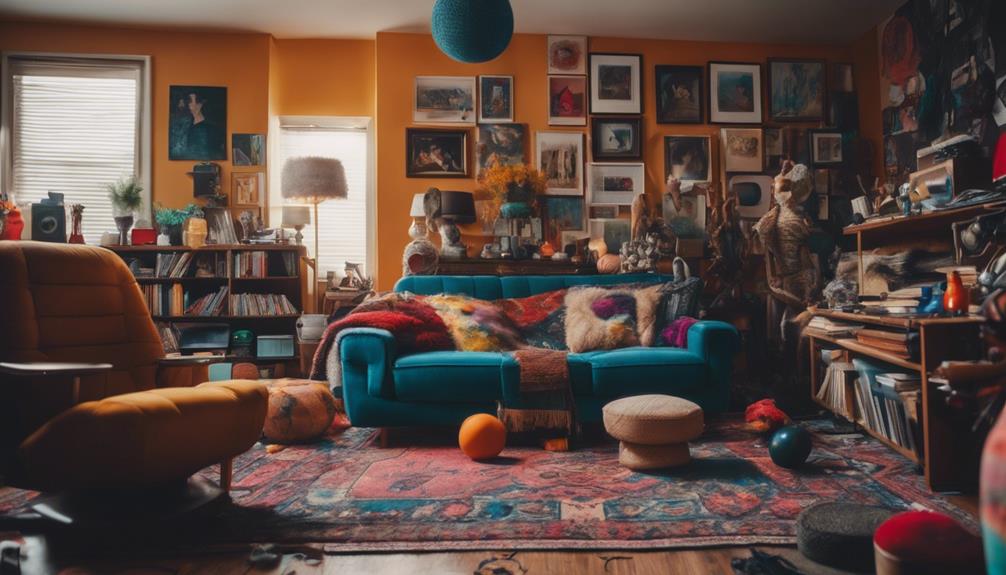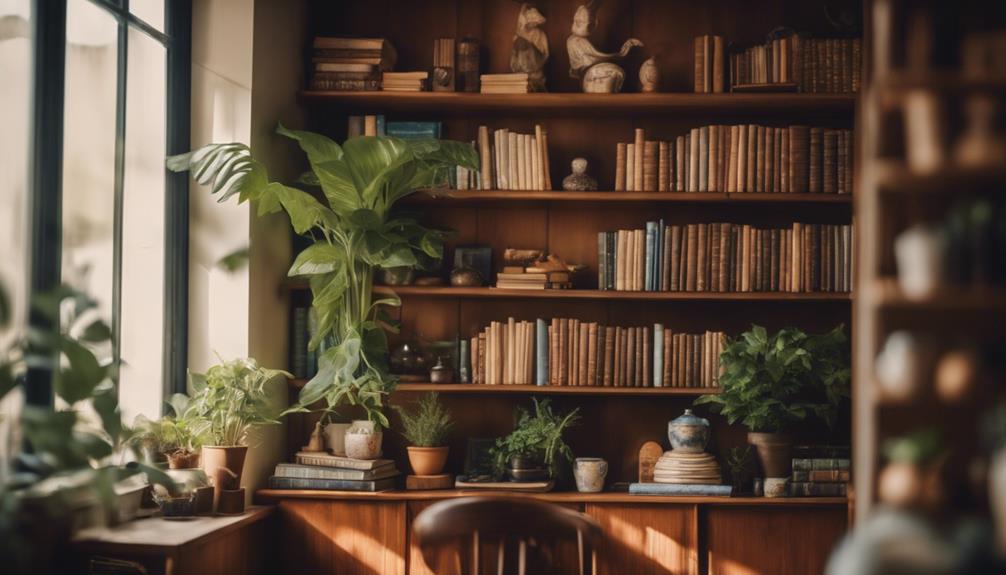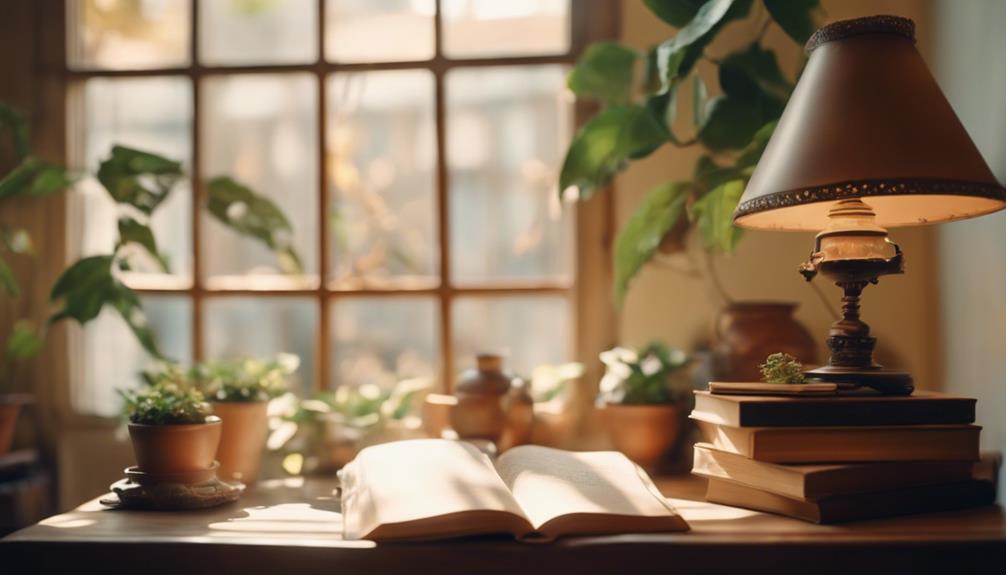In the world of interior design, modern madness shakes up minimalism, offering an eclectic twist that challenges the usual norms. It's a creative rebellion, pushing the boundaries of simplicity and inviting a new wave of innovation into living spaces. The fusion of diverse elements in this movement transforms traditional minimalism, breathing freshness and individuality into every room. If you're curious about how this shift is reshaping design principles, there's much more to discover within this exciting trend!
Key Takeaways
- Fusion of diverse elements creates an eclectic twist in minimalist design.
- Blending high-end and affordable items for a less-is-more approach.
- Reflecting individual taste with a curated, personalized look.
- Contemporary interpretation of traditional design principles.
- Embracing variety while maintaining clean, minimalist spaces.
Warm Minimalism Aesthetic
The Warm Minimalism Aesthetic embraces natural elements and cozy textures to create a welcoming atmosphere. In interior design, this aesthetic focuses on simplicity, warmth, and visual interest.
For your dining area, consider incorporating oak furniture and leather accents to infuse a sense of comfort and elegance. By blending minimalist principles with tactile materials, like wood and leather, you can soften the space while maintaining a modern look.
When considering warm minimalism, think about how early 20th-century modernist architects like Gerrit Rietveld and Mies van der Rohe have influenced this style. Their emphasis on nature-inspired colors and textures has shaped the way designers approach minimalist interiors today. To enhance the ambiance of your dining area, opt for earthy palettes and subtle wood accents.
To create a space that exudes warmth and simplicity, sustainability plays a key role in warm minimalism. By choosing sustainable materials and earthy colors, you can achieve a relaxed minimalist aesthetic that's both visually appealing and environmentally conscious.
Architectural Influences on Warm Minimalism

You'll find that modernist architects like Gerrit Rietveld and Ludwig Mies van der Rohe have heavily influenced warm minimalism by emphasizing simplicity and incorporating rich material palettes.
Open-plan interiors and a strong connection to nature are fundamental aspects of minimalist design inspired by early modernist architects, infusing minimalist spaces with a sense of warmth.
Architects often integrate views of the surrounding landscape into minimalist homes to introduce natural warmth and establish a serene atmosphere.
Architectural Icons' Influence
In shaping warm minimalism, architects like Gerrit Rietveld and Ludwig Mies van der Rohe have left a lasting influence with their emphasis on simplicity and clean lines. This influence can be seen in the design of key elements in a home, such as the dining table in the living room and the overall home decor.
Drawing inspiration from these architectural icons, warm minimalism incorporates open-plan interiors and a seamless connection to nature, creating spaces that exude tranquility and warmth. By integrating views of the surrounding landscape, minimalist homes establish a harmonious relationship between indoor and outdoor spaces, fostering a cozy ambiance.
Moreover, the use of natural, tactile materials like wood, stone, and leather softens the stark aesthetic of minimalism, echoing the early modernist architecture principles. Through this blend of simplicity and warmth, warm minimalism in architecture embraces the innovative design concepts of renowned architects, resulting in inviting and comfortable living spaces.
Natural Materials Integration
Drawing inspiration from modernist architects like Gerrit Rietveld and Ludwig Mies van der Rohe, the integration of natural materials is a defining feature in warm minimalism, infusing spaces with a sense of warmth and connection to nature. By incorporating elements like wood, leather, and sheer fabrics, warm minimalism bridges the gap between minimalism and comfort, creating inviting spaces that evoke a feeling of tranquility. The use of these organic materials not only adds visual interest but also introduces tactile sensations, engaging the senses in a harmonious way.
| Natural Materials in Warm Minimalism | Benefits |
|---|---|
| Wood | Adds warmth and texture to the space |
| Leather | Provides a luxurious and cozy feel |
| Sheer Fabrics | Allows natural light to filter through, creating an airy atmosphere |
Minimalism Warmth Connection
Modernist architects like Gerrit Rietveld and Ludwig Mies van der Rohe have left a lasting influence on warm minimalism, shaping the architectural principles that emphasize a connection between minimalism and warmth.
In warm minimalism, the integration of landscape views into minimalist homes creates a sense of coziness and comfort, drawing inspiration from the rich material palettes and open-plan interiors championed by these architects.
The use of natural, tactile, and organic materials further softens the starkness often associated with minimalist design, infusing spaces with a welcoming ambiance.
By blending simplicity with warmth derived from early modernist architecture, warm minimalism offers a unique approach that balances the clean lines of minimalism with a sense of inviting homeliness.
This architectural style aims to create living spaces that aren't only aesthetically pleasing but also emotionally comforting, showcasing how the principles of modernist architecture continue to shape contemporary design trends.
Minimalist Interior Design Elements

Neutral paint colors and undertones play an important role in impacting minimalist spaces, creating a sense of calm and simplicity. Bright colors are sparingly incorporated to add warmth and visual interest without overwhelming the minimalist aesthetic.
Displaying objects in an ordered fashion within minimalist interiors helps maintain a clean and organized appearance. Vintage furniture is often used to add character, coziness, and a sense of history to the design. Lighting is vital for creating ambiance, highlighting key elements, and transforming the overall feel of the space.
In minimalist design, the subtle use of color evokes a feeling of tranquility, allowing for a restful environment. The careful arrangement of objects fosters a sense of serenity and tidiness, promoting a peaceful mindset. Incorporating vintage pieces adds a touch of nostalgia and comfort, enveloping the space in a welcoming embrace.
Nature-Inspired Elements in Minimalist Design
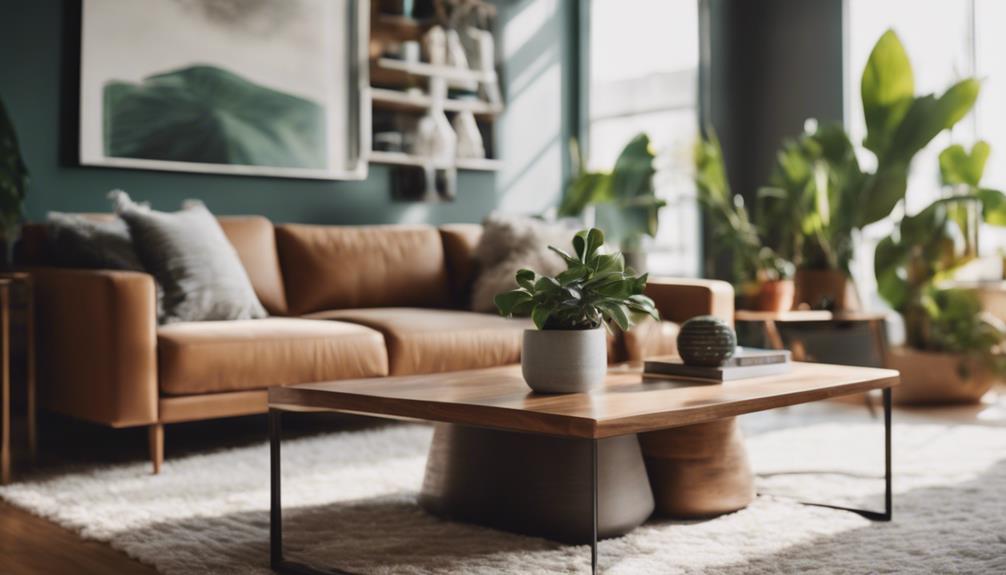
Embracing earthy tones and incorporating natural textures can infuse minimalist spaces with warmth and organic charm. By adding wood accents, tactile materials, and warm-toned elements, you can create a cozy and inviting atmosphere in areas like bathrooms.
Limiting contrasting textures within minimalist interiors can enhance comfort and the overall aesthetic appeal of the space. Engaging the senses through natural materials, textures, and earthy color palettes can elevate the minimalist design experience.
Elements such as wicker, wood, and Berber rugs can contribute notably to establishing a calming ambiance in minimalist spaces. These nature-inspired additions bring a sense of tranquility and connection to the outdoors, creating a harmonious balance between simplicity and warmth.
Incorporating these elements into your minimalist design can transform your space into a serene sanctuary that reflects the beauty of the natural world.
Sustainability and Minimalist Design
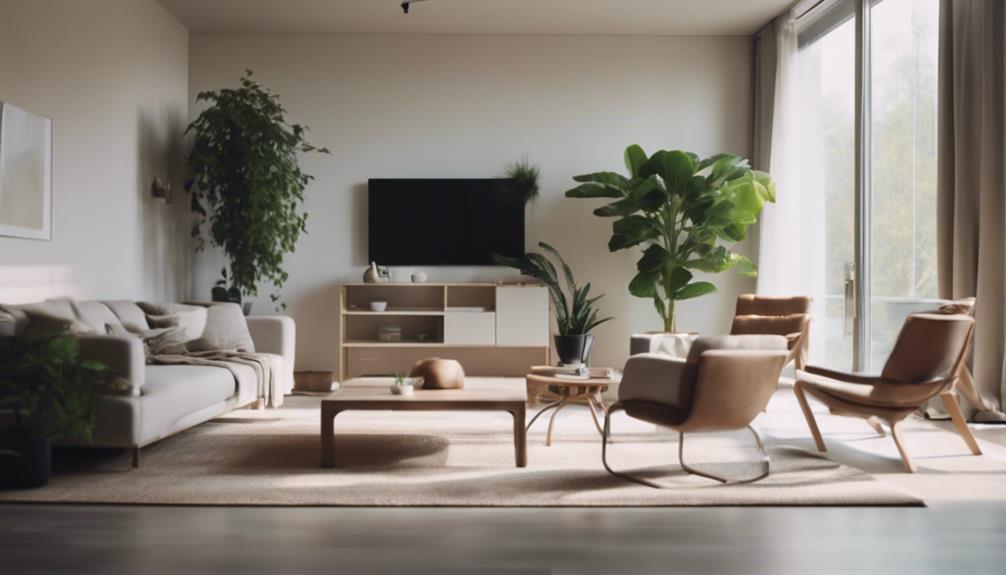
You can see a shift towards sustainability in minimalist design, with a focus on eco-friendly materials and earthy mid-tone color palettes.
The trend emphasizes simpler lifestyles and conscious choices to create more environmentally-friendly interiors.
Sustainable Material Choices
Sustainable material choices play a pivotal role in modern minimalist design, emphasizing eco-friendly options like bamboo, cork, and reclaimed wood to reduce environmental impact and promote conscious living. When you opt for sustainable materials in your minimalist interiors, you're making a positive impact on the environment while creating a healthier space for yourself. By choosing bamboo, cork, or reclaimed wood, you're contributing to a more eco-conscious lifestyle and supporting ethical sourcing practices.
Eco-friendly design options not only enhance the aesthetics of your space but also align with your values of sustainability and responsibility. Selecting bamboo, cork, or reclaimed wood for your minimalist design reflects your dedication to a greener future. Incorporating sustainable materials into your living space fosters a sense of harmony with nature. Choosing eco-friendly options like bamboo and cork showcases your commitment to conscious living practices.
Earthy Mid-Tone Palettes
In minimalist design, the incorporation of earthy mid-tone palettes signifies a conscious shift towards sustainability and eco-conscious choices.
These palettes encompass warm, nature-inspired colors like terracotta, olive green, and burnt sienna, evoking a sense of natural harmony within minimalist interiors.
Sustainability is evident through the use of natural materials such as wood, stone, and linen, enhancing the eco-friendly appeal of these design choices.
The earthy mid-tone palettes not only contribute to a calming and inviting atmosphere in minimalist spaces but also serve as a visual reminder of the importance of embracing sustainable practices.
Moreover, the focus on sustainability extends beyond color choices to include furniture, decor, and the overall aesthetic of minimalist design.
Simplifying Lifestyles
Opting for minimalist design principles encourages a shift towards simpler lifestyles that prioritize sustainability and mindful consumption. Embracing this approach not only brings aesthetic harmony but also contributes to a more eco-friendly and conscious way of living.
By simplifying your lifestyle through minimalist design, you are:
- Reducing your environmental footprint and supporting sustainable practices.
- Cultivating a sense of calm and tranquility in your living spaces.
- Making intentional choices that promote a healthier planet for future generations.
Choosing sustainable materials, incorporating earthy tones, and embracing a minimalist aesthetic can transform your home into a sanctuary that not only looks beautiful but also aligns with your values.
Embracing simplicity in design not only enhances your living environment but also fosters a deeper connection to the world around you.
Eclectic Minimalism
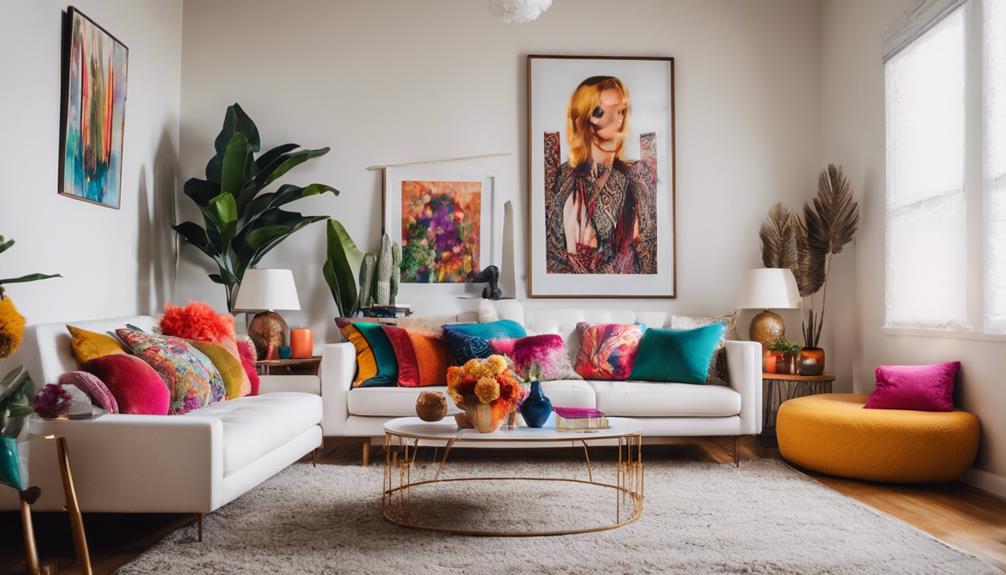
With its fusion of diverse elements, eclectic minimalism offers a fresh and personalized take on modern interior design. This style combines the love of variety with clean, minimalist spaces, resulting in a unique and personalized aesthetic.
By mixing antiques and modern pieces, eclectic minimalism achieves a less-is-more approach that blends high-end and affordable items seamlessly. Drawing inspiration from artists like Georgia O'Keeffe, this design ethos embraces a curated look that reflects individual taste and personality.
Incorporating elements like a chandelier from a vintage market in Nice can infuse character and charm into eclectic minimalist interiors. The concept of mixing old and new allows eclectic minimalism to provide a contemporary twist on traditional design principles, creating a dynamic and visually appealing space that speaks to the individuality of its inhabitants.
If you're looking to break away from conventional design norms and inject your space with personality and style, eclectic minimalism might just be the perfect fit for you.
Diy Kitchen Paint

Consider enhancing your kitchen space with a fresh coat of DIY paint to revamp its look and feel. DIY kitchen paint projects offer a creative and budget-friendly way to transform your cooking area.
Here are some ideas to inspire your next kitchen makeover:
- Incorporate a white farmhouse sink for a touch of rustic charm.
- Update your kitchen with painted wood floors, a trendy and cost-effective option for a modern look.
- Create a classic and timeless vibe with checkered floors, adding character to your DIY kitchen paint makeover.
Country Look

Embrace the cozy charm of the Country Look with its blend of vintage allure and modern simplicity, as showcased in antiques dealer Jonathan Burden's Shelter Island retreat. Burden's restoration approach breathes new life into spaces, emphasizing natural materials and timeless design elements.
The Country Look effortlessly marries old-world charm with contemporary clean lines, crafting inviting interiors that feel both familiar and fresh. Burden's Shelter Island retreat exudes this aesthetic, featuring a thoughtfully curated mix of antique pieces and modern accents.
This design ethos captures the rustic essence of farmhouse style while maintaining an air of sophistication through carefully selected decor. The result is a space that's warm, welcoming, and effortlessly stylish.
Frequently Asked Questions
What Is Minimal Eclecticism?
Minimal eclecticism is a fusion of minimalist design principles with eclectic elements. You blend clean lines and simplicity with diverse styles, textures, and colors. It allows for mixing vintage pieces and quirky accents within a minimalist framework, encouraging creativity and self-expression.
Is Minimalism Still Popular in 2024?
Yes, minimalism is still popular in 2024. Imagine sleek lines, serene spaces, and sustainable choices. It's not just a trend; it's a lifestyle. Quality over quantity resonates, making minimalism a timeless choice.
Why Is Minimalism Taking Over?
Minimalism is taking over because it simplifies life, reduces stress, and fosters calm. By owning fewer possessions and focusing on experiences, you can declutter your space, increase productivity, and prioritize what truly matters.
How Many People Like Minimalism?
You'd be surprised to know that a whopping 57% of Americans prefer the sleek simplicity of minimalism in their homes. Millennials are leading the pack, with 64% loving minimalist decor for its calming and clutter-free vibes.
Conclusion
You've seen how minimalism is evolving into a warm and eclectic style, blending simplicity with unique touches.
In fact, 68% of interior designers report an increase in clients requesting a mix of minimalist and eclectic design elements in their homes.
With influences from nature, architecture, and sustainability, modern minimalism is breaking away from its traditional roots and embracing a new era of creativity and individuality.
Embrace the eclectic twist and make your space truly your own!

